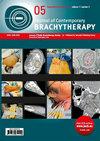Clinical efficacy analysis of radioactive 125I particle implantation for the treatment of pelvic local recurrence of cervical cancer after radiotherapy
IF 1.1
4区 医学
Q4 ONCOLOGY
引用次数: 0
Abstract
Purpose:To explore the efficacy of CT-guided iodine-125 (125I) radioactive particle implantation for the treatment of pelvic local recurrence of cervical cancer after radiotherapy.
Material and methods:
To analyze clinical data of 46 patients with pelvic local recurrence of cervical cancer after radiotherapy, who underwent 125I particle implantation, post-operative follow-up using Kaplan-Meier method to calculate the rate of local control, and observation of complications. Univariate and multi-factorial analyses were performed with log-rank test and Cox regression statistical method to observe changes in serum SCC-Ag and CEA levels.
Results:
A total of 57 lesions in 46 patients had a short-term local control rate of 87.72% (50/57) and effective rate of 68.42% (39/57). As of the end of follow-up, the median local progression-free survival time of 46 patients was 12.2 (range, 3.5-32) months, the median overall survival time was 16.3 (range, 3.5-40) months, with 1-year and 2-year OS of 63.04% and 41.30%. Univariate and multi-factorial analyses suggested that local recurrent mass size and recurrence site were the main factors affecting survival. Loco-regional progression-free survival (LPFS) time was 15.5 and 11.25 months in cases with recurrent mass diameter < 3 cm and ≥ 3 cm, respectively (χ2 = 10.83, p = 0.001 < 0.05). In patients with pelvic wall recurrence and central recurrence, the time to LPFS was 15.80 and 10.00 months, respectively (χ2 = 8.833, p = 0.0030 < 0.05). Tumor markers serum SCC-Ag and CEA decreased to different degrees after treatment, and the difference was statistically significant. The median LPFS in the SCC-Ag ≤ 3.5 ng/ml group was significantly higher than that in the SCC-Ag > 3.5 ng/ml group (χ2 = 4.241, p = 0.036 < 0.05). No serious post-operative complications were observed.
Conclusions:
CT-guided 125I seed implantation has significant short-term efficacy in the treatment of pelvic local recurrence of cervical cancer after radiotherapy. It can improve the effective rate in patients with initial clinical stage II, especially in those with locally recurrent masses < 3 cm and in those with a recurrence in the pelvic wall.
放射性 125I 粒子植入治疗放疗后宫颈癌盆腔局部复发的临床疗效分析
目的:探讨CT引导下碘-125(125I)放射性粒子植入治疗宫颈癌放疗后盆腔局部复发的疗效。材料与方法:分析46例宫颈癌放疗后盆腔局部复发患者接受125I粒子植入治疗的临床资料,术后随访采用Kaplan-Meier法计算局部控制率,观察并发症发生情况。结果:46名患者共57个病灶,短期局部控制率为87.72%(50/57),有效率为68.42%(39/57)。截至随访结束,46名患者的中位局部无进展生存时间为12.2个月(3.5-32个月),中位总生存时间为16.3个月(3.5-40个月),1年和2年OS分别为63.04%和41.30%。单变量和多因素分析表明,局部复发肿块大小和复发部位是影响生存期的主要因素。复发肿块直径< 3厘米和≥3厘米的病例的局部区域无进展生存期(LPFS)分别为15.5个月和11.25个月(χ2 = 10.83,P = 0.001 < 0.05)。盆壁复发和中心复发患者的 LPFS 时间分别为 15.80 个月和 10.00 个月(χ2 = 8.833,P = 0.0030 <0.05)。肿瘤标志物血清SCC-Ag和CEA在治疗后有不同程度的下降,差异有统计学意义。SCC-Ag≤3.5 ng/ml组的中位LPFS明显高于SCC-Ag > 3.5 ng/ml组(χ2 = 4.241, p = 0.036 <0.05)。结论:CT引导下125I粒子植入治疗宫颈癌放疗后盆腔局部复发的短期疗效显著。它能提高初始临床分期为II期的患者的有效率,尤其是那些局部复发肿块< 3厘米和盆腔壁复发的患者。
本文章由计算机程序翻译,如有差异,请以英文原文为准。
求助全文
约1分钟内获得全文
求助全文
来源期刊

Journal of Contemporary Brachytherapy
ONCOLOGY-RADIOLOGY, NUCLEAR MEDICINE & MEDICAL IMAGING
CiteScore
2.40
自引率
14.30%
发文量
54
审稿时长
16 weeks
期刊介绍:
The “Journal of Contemporary Brachytherapy” is an international and multidisciplinary journal that will publish papers of original research as well as reviews of articles. Main subjects of the journal include: clinical brachytherapy, combined modality treatment, advances in radiobiology, hyperthermia and tumour biology, as well as physical aspects relevant to brachytherapy, particularly in the field of imaging, dosimetry and radiation therapy planning. Original contributions will include experimental studies of combined modality treatment, tumor sensitization and normal tissue protection, molecular radiation biology, and clinical investigations of cancer treatment in brachytherapy. Another field of interest will be the educational part of the journal.
 求助内容:
求助内容: 应助结果提醒方式:
应助结果提醒方式:


